Sonova USA NLCROS Accessory for CI sound processor User Manual User Guide Phonak Naida Link CROS
Phonak Inc Accessory for CI sound processor User Guide Phonak Naida Link CROS
UserManual
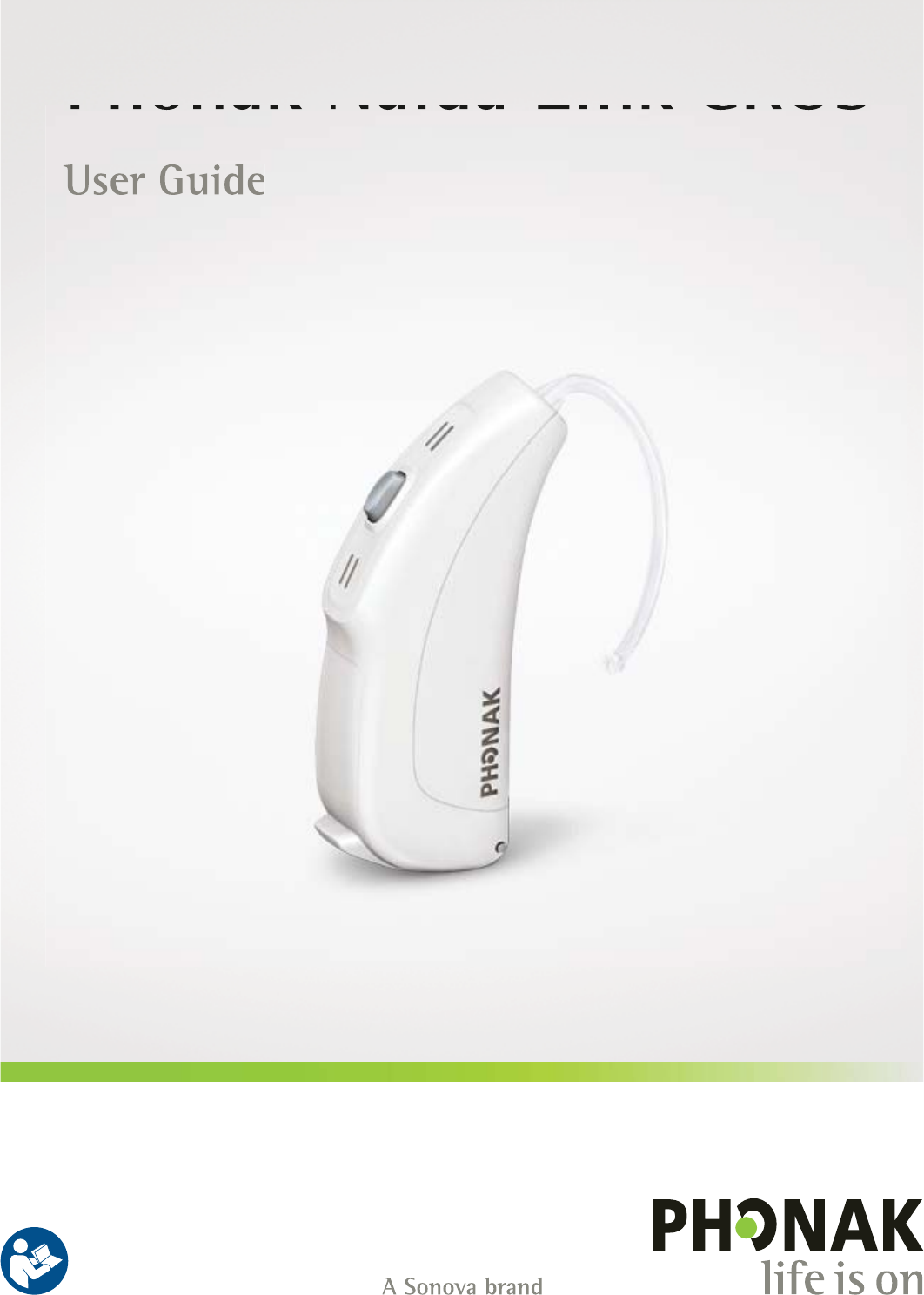
User Guide
Phonak Naída Link CROS

3
Wireless models
Phonak Naída Link CROS
CE mark applied
2017
This user guide is valid for:
Your CROS device
Model
Naída Link CROS
Earpiece
F Dome
F CROS Tip
Battery type
13
This user guide only applies to the CROS device.
Please see the AB Naída CI sound processor user
guide for instructions related to the AB Naída CI
sound processor.

4 5
Your CROS device has been developed by Phonak – the world
leader in hearing solutions based in Zurich, Switzerland.
This premium product is the result of decades of research
and expertise and is designed to keep you connected to
the beauty of sound! We thank you for making such a
great choice and wish you many years of
listening pleasure.
Please read the User Guide carefully to make sure that
you understand and get the best out of your CROS device.
For more information about features and benets, simply
contact your hearing care professional.
Phonak - life is on
www.phonak.com
Contents
Your CROS device
1. Quick guide
2. Parts of the CROS device
Using the CROS device
3. Left & right CROS device markings
4. On/O
5. Batteries
6. Putting on the CROS device
7. Removing the CROS device
8. Push button
Further Information
9. Care and maintenance
10. Service and warranty
11. Compliance information
12. Information and description of symbols
13. Troubleshooting
14. Important safety information
6
8
10
11
12
14
15
16
17
20
22
26
30
32
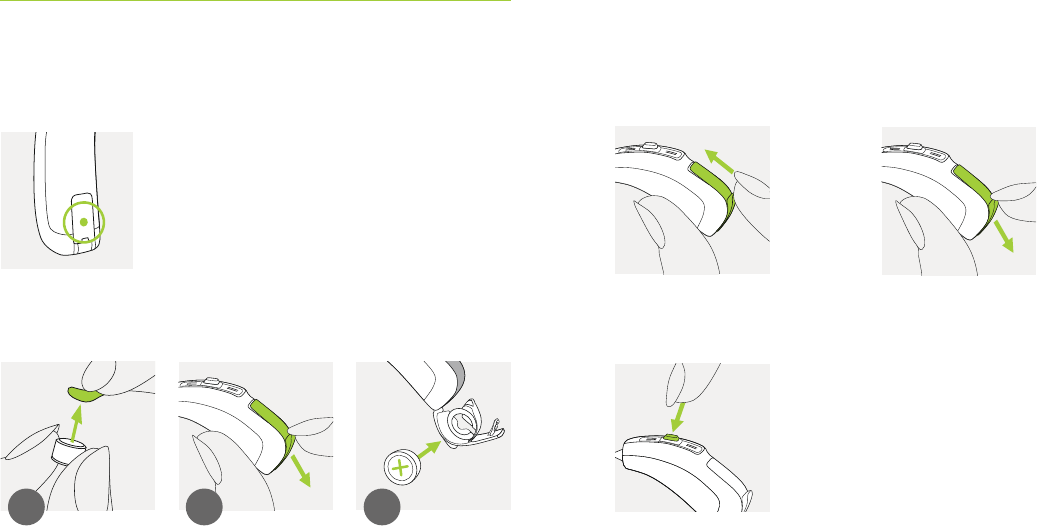
6 7
1. Quick guide
Left & right markings On/O
Changing batteries Push button
1 2 3
Blue marking for left device.
Red marking for right device.
Remove the
sticker from the
new battery and
wait two minutes.
Open the
battery door.
Place battery in
the battery door
with the “+”
symbol facing
upwards.
The push button on your device
functions as a mute button to mute
the sound delivered from the CROS
device.
OOn
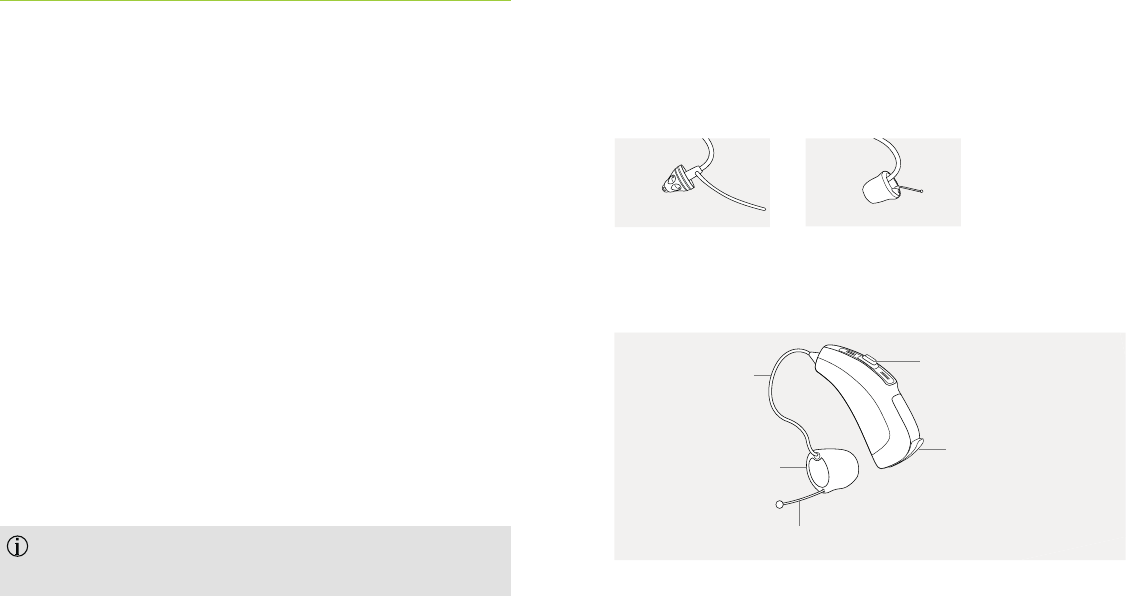
8 9
2. Parts of the CROS device
Phonak Naída Link CROS is a dedicated product for
unilaterally implanted Naída CI recipients with an
unaidable hearing loss on the contralateral ear. The Naída
Link CROS is worn on the unaidable ear in combination
with the AB Naída CI sound processor on the other ear.
Naída Link CROS transfers the microphone input signal to
the AB Naída CI sound processor. The sound processor
receives the signal and makes sounds from the other side
audible. Naída Link CROS has no acoustical output.
Phonak Naída Link CROS device + AB Naída CI sound
processor = Naída Link CROS solution
Possible earpieces for the Naída Link CROS device
CROS Tip
Push
button
Naída Link CROS
Tube
Removal handle
Battery
door
Dome CROS Tip
Phonak Naída Link CROS only works in connection
with a compatible AB Naída CI sound processor.
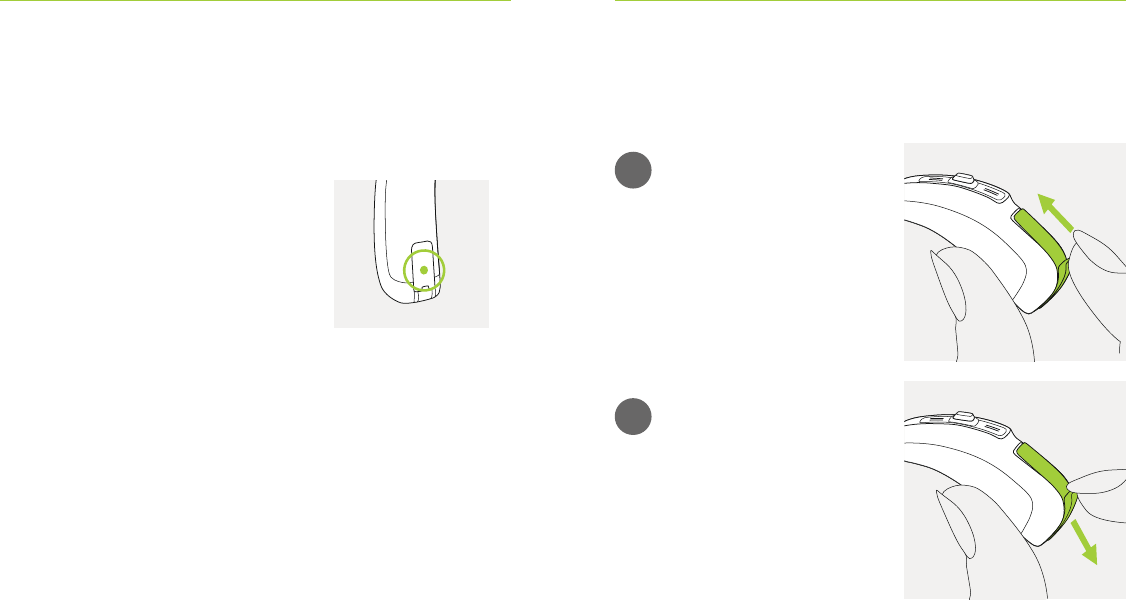
10 11
3. Left & right CROS device markings 4. On/O
The battery door is also the on/o switch.
1
2
Closed battery door =
CROS device is on
Open battery door =
CROS device is o
There is a red or blue marking to tell you if it is a left or a
right device.
Blue marking for left device.
Red marking for right device.
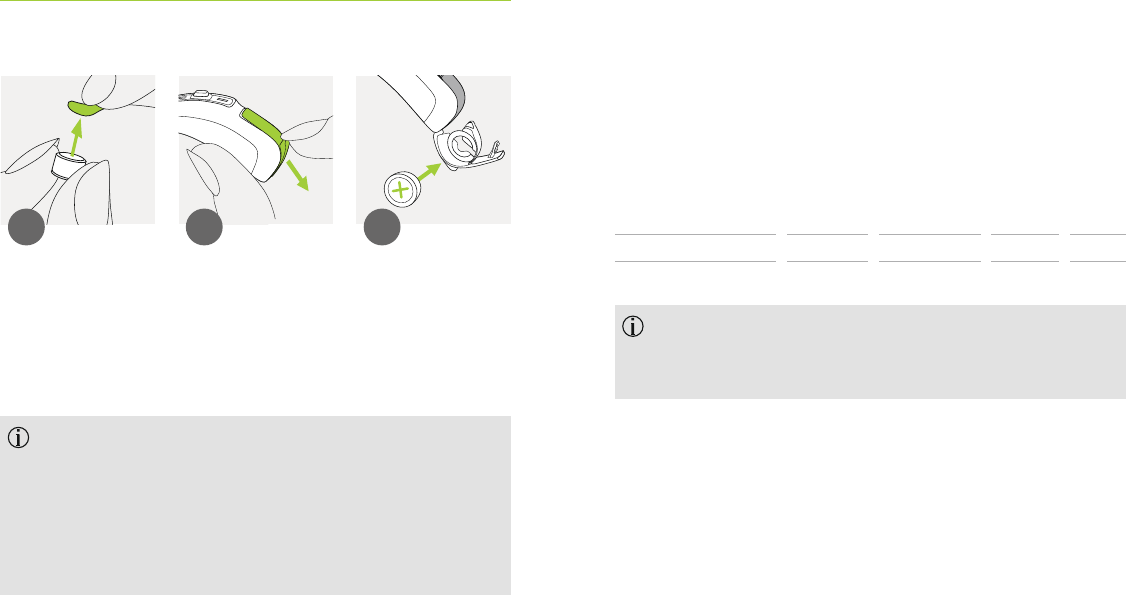
12 13
5. Batteries
1 2 3
Remove the
sticker from the
new battery and
wait two minutes.
Open the
battery door.
Place battery in
the battery door
with the “+”
symbol facing
upwards.
If it is dicult to close the battery door: Check that
the battery is inserted correctly and the “+” symbol
is facing the “+” label inside the battery
compartment. If the battery is not inserted
correctly, the CROS device will not work and the
battery door can be damaged.
Model
Naída Link CROS
Zinc air
battery
size
13
Color
marking on
package
orange
IEC
code
PR48
ANSI
code
7000ZD
Replacement battery
This CROS device requires zinc-air batteries.
Please ensure you use the correct type of battery in
your CROS device (zinc-air). Please also read chapter
14.2 for further information on product safety.
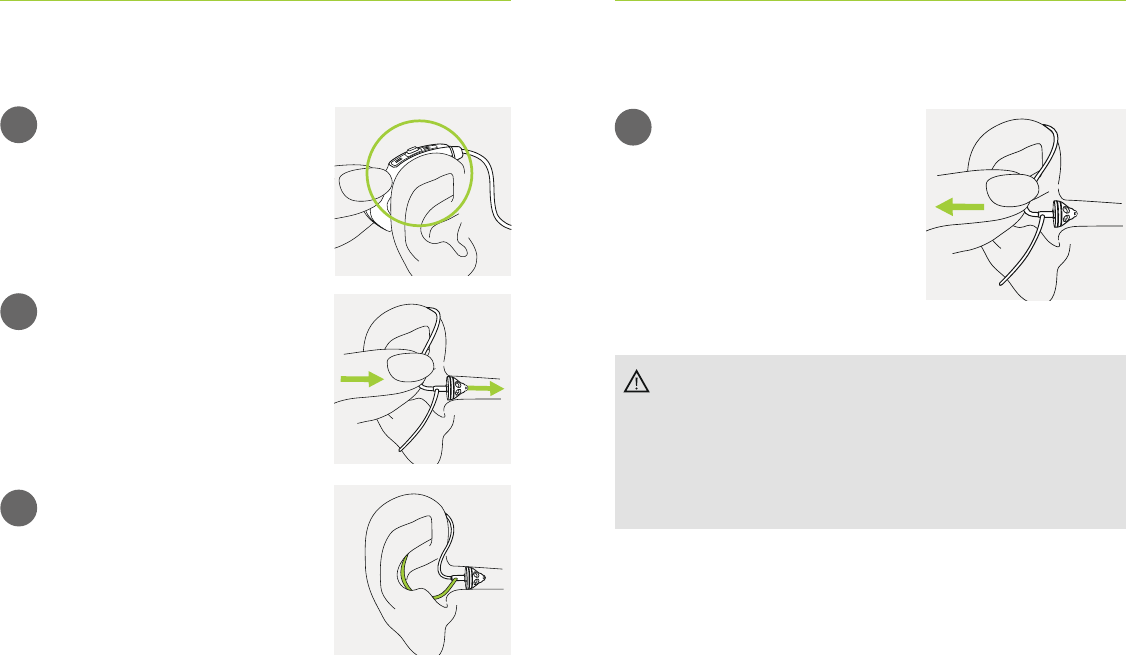
14 15
6. Putting on the CROS device
1
2
3
Place the CROS device behind
your ear.
Insert the earpiece into your
ear canal.
If there is an anchor attached
to the earpiece, tuck it into the
bowl of your ear to secure your
CROS device.
7. Removing the CROS device
1
Pull on the bend of the tube
and remove the CROS device
from behind the ear.
In very rare cases, your earpiece can remain in your
ear canal when removing the device from the ear.
In the unlikely case that the earpiece does get stuck
in your ear canal, it is strongly recommended to see
a medical specialist for safe removal.

16 17
8. Push button
The push button on your
CROS device functions as
a mute button to mute
the sound delivered from
the CROS device.
9. Care and maintenance
Diligent and routine care of your CROS device contributes
to outstanding performance and a long service life.
Please use the following specications as a guideline.
Further information regarding product safety, see
chapter 14.2.
General information
Before using hair spray or applying cosmetics, you should
remove your CROS device from your ear, because these
products may damage it.
When you are not using your CROS device, leave the
battery door open so that any moisture can evaporate.
Make sure that you always completely dry your CROS
device after use. Store it in a safe, dry and clean place.
Your CROS device is resistant to water, sweat and dust
under the following conditions:

18 19
• The battery door is fully closed. Ensure that no foreign
object such as hair is caught in the battery door when it
is closed.
• After exposure to water, sweat or dust, the device is
cleaned and dried.
• The CROS device is used and maintained as described in
this user guide.
Use of your CROS device around water can restrict
air ow to the batteries causing it to stop working.
Should your CROS device stop working after
coming into contact with water, refer to the
troubleshooting steps in chapter 13.
Daily
Inspect the earpiece for earwax and moisture deposits.
Clean the surfaces with a lint-free cloth or use the small
brush provided in the hard case. Never use cleaning
agents such as household detergents, soap, etc. for
cleaning your CROS device. It is not recommended to
rinse with water. If you need to clean your CROS device
intensively, ask your hearing care professional for advice
and information on drying capsules.
Weekly
Clean the earpiece with a soft, damp cloth or with a
special cleaning cloth for hearing aids. For more in depth
maintenance instructions or for more than basic cleaning,
please see your hearing care professional.
Monthly
Inspect your tube for color changes, hardening, or
cracks. In the case of such changes, the tube has to be
replaced. Please see your hearing care professional.

20 21
10. Service and warranty
Local warranty
Please ask the hearing care professional, where you
purchased your CROS device, about the terms of the
local warranty.
International warranty
Sonova AG oers a one year limited international
warranty, valid from the date of purchase. This
limited warranty covers manufacturing and material
defects in the CROS device itself, but not accessories
such as batteries, tubes, earmolds, external receivers.
The warranty only comes into force if a proof of
purchase is shown.
The international warranty does not aect any legal
rights that you might have under applicable national
legislation governing sale of consumer goods.
Warranty limitation
This warranty does not cover damage from improper
handling or care, exposure to chemicals or undue stress.
Damage caused by third parties or non-authorized service
centers renders the warranty null and void. This warranty
does not include any services performed by a hearing care
professional in their oce.
Serial number:
Date of purchase:
Authorized hearing care
professional (stamp/signature):

22 23
Europe:
Declaration of Conformity
Hereby Sonova AG declares that this product meets the
requirements of the Medical Devices Directive 93/42/EEC
as well as the Radio and Telecommunications Terminal
Equipment Directive 1999/5/EC. The full text of the
Declaration of Conformity can be obtained from the
manufacturer or the local Phonak representative whose
address can be taken from the list on www.phonak.com
(Phonak worldwide locations).
11. Compliance information
Australia/New Zealand:
Indicates a device’s compliance with applicable
Radio Spectrum Management’s (RSM) and
Australian Communications and Media Authority
(ACMA) regulatory arrangements for the legal sale
in New Zealand and Australia.
The compliance label R-NZ is for radio products
supplied in the New Zealand market under
conformity level A1.
The wireless model listed on page 2 is certied under:
Phonak Naída Link CROS
USA FCC ID: KWC-NLCROS
Canada IC: 2262A-NLCROS
24 25
interference to radio communications. However, there is
no guarantee that interference will not occur in a
particular installation. If this device does cause harmful
interference to radio or television reception, which can be
determined by turning the equipment o and on, the user
is encouraged to try to correct the interference by one or
more of the following measures:
• Reorient or relocate the receiving antenna.
• Increase the separation between the device
and receiver.
• Connect the device into an outlet on a circuit
dierent from that to which the receiver is connected.
• Consult the dealer or an experienced radio/TV
technician for help.
Notice 1:
This device complies with Part 15 of the FCC Rules and
with RSS-210 of Industry Canada. Operation is subject to
the following two conditions:
1) this device may not cause harmful interference, and
2) this device must accept any interference received,
including interference that may cause undesired operation.
Notice 2:
Changes or modications made to this device not
expressly approved by Sonova AG may void the FCC
authorization to operate this device.
Notice 3:
This device has been tested and found to comply with
the limits for a Class B digital device, pursuant to Part 15
of the FCC Rules and ICES-003 of Industry Canada.
These limits are designed to provide reasonable protection
against harmful interference in a residential installation.
This device generates, uses and can radiate radio
frequency energy and, if not installed and used in
accordance with the instructions, may cause harmful
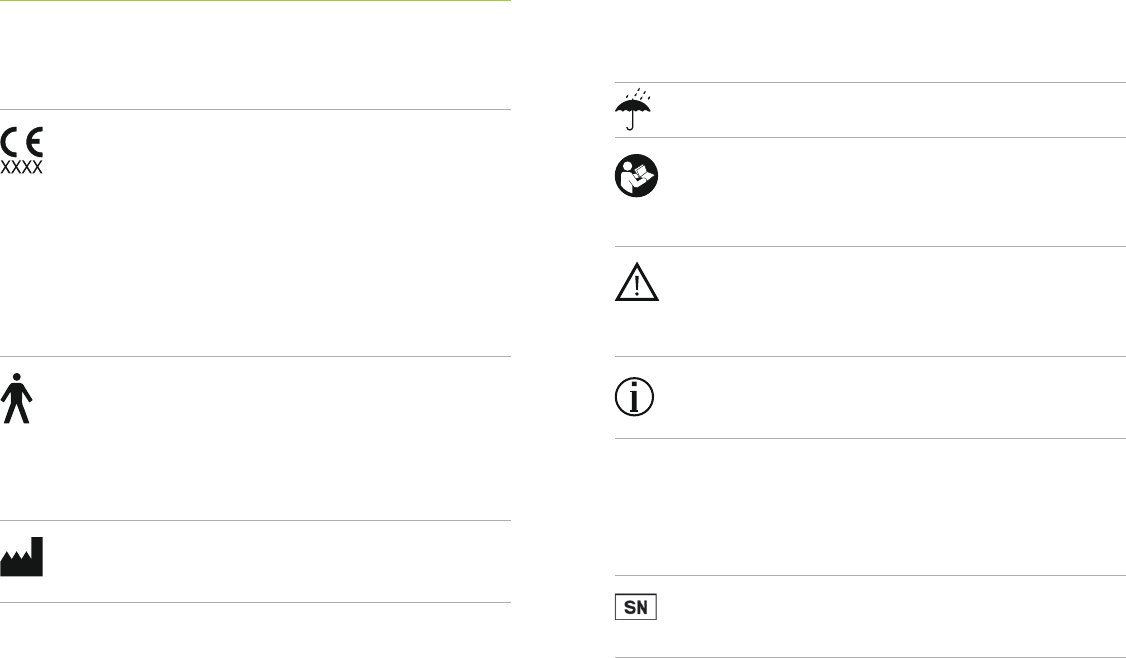
26 27
During transportation keep dry.
This symbol indicates that it is important for the
user to read and take into account the relevant
information in these user guides.
This symbol indicates that it is important for the
user to pay attention to the relevant warning
notices in these user guides.
Important information for handling and product
safety.
The product is designed such that it functions
without problems or restrictions if used as
intended, unless otherwise noted in these
user guides.
Indicates the manufacturer’s serial number so that
a specic medical device can be identied.
Operating
conditions
12. Information and description
of symbols
With the CE symbol, Sonova AG conrms that this
product – including accessories – meets the
requirements of the Medical Devices Directive
93/42/EEC as well as the R&TTE Directive 1999/5/
EC on radio and telecommunications equipment.
The numbers after the CE symbol correspond to
the code of certied institutions that were
consulted under the above-mentioned directives.
This symbol indicates that the products described
in these user instructions adhere to the
requirements for an applied part of Type B of
EN 60601-1. The surface of the hearing aid is
specied as an applied part of Type B.
Indicates the medical device manufacturer, as
dened in EU Directive 93/42/EEC.

28 29
Indicates the manufacturer’s catalogue number so
that the medical device can be identied.
Temperature during transportation
and storage: –20° to +60° Celsius
(–4° to +140° Fahrenheit).
Humidity during transportation: Up to 90% (non
condensing). Humidity during storage: 0% to 70%,
if not in use. See instruction in chapter 15.2
regarding drying the device after use.
Atmospheric pressure: 200 hPA to 1500 hPa
The symbol with the crossed-out garbage bin is to
make you aware that this device may not be thrown
away as normal household waste. Please dispose
of old or unused device, at waste disposal sites
intended for electronic waste, or give your device to
your hearing care professional for disposal. Proper
disposal protects the environment and health.

30 31
13. Troubleshooting
If the problem persists, contact your hearing care professional
for assistance
Causes
Flat battery
Battery not inserted correctly
CROS device switched o
CROS device in mute mode
CROS device out of range of AB sound
processor
Problem
CROS device not
functioning
No audio detected from
the CROS side
What to do
Change battery (chapter 1 + 5)
Insert battery correctly (chapter 1 + 5)
Switch CROS device on by completely closing the battery door
(chapter 4)
Press push button on the CROS device to so that the sound is no longer
muted (chapter 8)
Place CROS device within range of the AB Naída CI sound processor
that is on the opposite ear

32 33
Please read the information on the following pages before
using your CROS device.
A CROS device will not restore normal hearing and will not
prevent or improve a hearing impairment resulting from
organic conditions. Infrequent use does not permit a user to
attain full benet from it. The use of a CROS device is only
part of hearing habilitation and may need to be supplemented
by auditory training and instruction in lipreading.
14. Important safety information
The intended use of this
CROS device is to transmit
sound to an AB Naída CI
sound processor on the
other ear and hereby
compensate for impaired
hearing. The CROS device
must only be used by the
intended person.
Changes or modications
to the CROS device that
were not explicitly
approved by Sonova AG
are not permitted. Such
changes may damage your
ear or the CROS device.
Do not use the CROS
device in explosive areas
(mines or industrial areas
with danger of explosions,
oxygen rich environments
or areas where ammable
anesthetics are handled)
or where electronic
equipment is prohibited.
Hearing aid batteries are
toxic if they are swallowed!
Keep out of the reach of
children, individuals with
cognitive impairment, and
pets. If batteries are
swallowed, consult your
physician immediately!
14.1 Hazard warnings

34 35
If you feel pain in or
behind your ear, if it is
inamed or if skin
irritation and accelerated
accumulations of earwax
occur, please check with
your hearing care
professional or physician.
In very rare cases, the
earpiece can remain in
your ear canal when
removing the hearing
tube from the ear. In the
unlikely case that the
earpiece does get stuck
in your ear canal, it is
strongly recommended
to see a physician for
safe removal.
Hearing programs in
the directional microphone
mode reduce background
noises. Please be aware
that warning signals or
noises coming from
behind, e. g. cars, are
partially or entirely
suppressed.
This CROS device is
not for children below 36
months. It contains small
parts that can cause
choking, if swallowed by
children. Keep out of the
reach of children,
individuals with cognitive
impairment, and pets.
If swallowed, consult a
physician or hospital
immediately.
Do not make a wire
connection from your
CROS device to any
external audio sources like
radio etc. That could cause
injuries on your body
(electric shock).
The following is only
applicable for persons with
active implantable medical
devices (i.e. pacemakers,
debrillators, etc.).
• Keep the CROS device at
least 15 cm (6 inches)
away from the active
implant. If you experience
any interference, do not
use the CROS device and
contact the manufacturer
of the active implant.
Please note that
interference can also be
caused by power lines,
electrostatic discharge,
airport metal detectors etc.
• Keep magnets (i.e. battery
handling tool, EasyPhone
magnet, etc.) at least
15 cm (6 inches) away
from the active implant.
• If using a Phonak wireless
accessory, consult the
chapter “Important safety
information” in your
wireless accessory user
guide.
• Naída Link CROS can be
safely worn and operated
contralateral to the AB
Naída CI sound processor
from Advanced Bionics.

36 37
Never immerse your CROS
device in water! Protect it
from excessive moisture.
Always remove your CROS
device before showering,
bathing, or swimming.
Never wash the microphone
inputs. Doing so could cause
it to lose its special acoustic
features.
Protect your CROS device
from heat (never leave near
a window or in the car).
Never use a microwave
or other heating devices
to dry your CROS device.
Ask your hearing care
professional about
suitable drying methods.
14.2 Information on product safety
The dome should be
changed every three
months or when it
becomes sti or brittle.
This is to prevent the dome
from detaching from the
tube spout during insertion
into or removal from the
ear.
When you are not using
your CROS device, leave
the battery door open so
that any moisture can
evaporate. Make sure that
you always completely dry
your CROS device after use.
Store the CROS
device in a safe, dry and
clean place.
The CROS device should not
be tted with domes / wax
protection systems when
used by clients with
perforated eardrums,
inamed ear canals or
otherwise exposed middle
ear cavities. In the unlikely
case that any part of this
product should remain in
the ear canal, it is strongly
recommended to see a
medical specialist for safe
removal.

38 39
Do not drop your CROS
device! Dropping onto a
hard surface can damage
your CROS device.
Always use new batteries
for your CROS device. In
case a battery is leaking,
replace it immediately
with a new one to avoid
any skin irritation. You
can return used batteries
to your hearing care
professional.
The batteries used in the
CROS device should not
exceed 1.5 Volts. Please
do not use silver-zinc or
lithium-ion rechargeable
batteries as these may
cause severe damage to
your CROS device. The
table in chapter 5 explains
exactly which type of
battery your CROS
device requires.
Remove the battery if
you are not using your
CROS device for a long
period of time.
Special medical or dental
examination including
radiation described below,
may adversely aect the
correct functioning of your
CROS device. Remove and
keep them outside the
examination room/area
before undergoing:
• Medical or dental
examination with X-ray
(also CT scan).
• Medical examinations with
MRI/NMRI scans, generating
magnetic elds.
• CROS devices don’t need to
be removed when passing
security gates (airports
etc.). If X-ray is used at all,
it will be in very low doses,
and will not aect the
CROS device.

Manufacturer:
Sonova AG
Laubisrütistrasse 28
CH-8712 Stäfa
Switzerland
www.phonak.com
029-0486-02/V1.00/2017-02/FO © Sonova AG All rights reserved
Your hearing care professional: